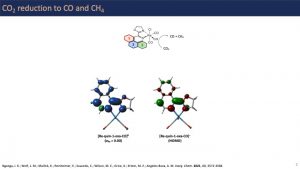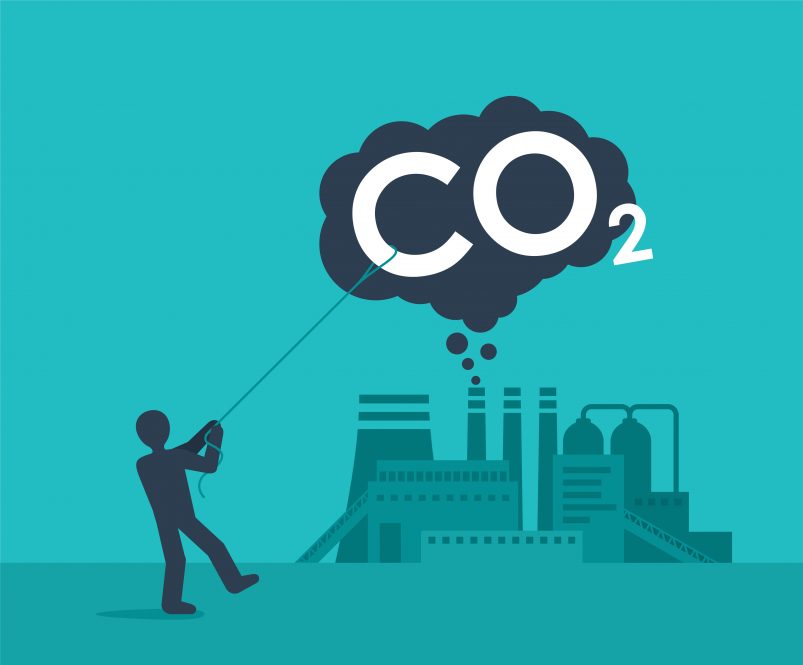Within the last month, everyone on Earth experienced something no human has experienced before – the concentration of atmospheric carbon dioxide exceeded 421 parts per million (ppm). To put this into perspective, pre-industrial revolution levels of CO2 were at about 280 ppm, and now we are at the highest levels seen in more than 3 million years.
Yet as awareness of the problem with greenhouse gas emissions rise, emissions themselves also continue to rise, setting off a cascade of feedback loops that exacerbate the problem. As a result, we – especially those of us residing in countries responsible for the bulk of emissions – are going to have to use every tool possible to tackle the problem of emissions. This includes planting forests, drastically reducing emissions, and exploring technology to help capture excess carbon from the atmosphere.
UConn Associate Professor of Chemistry Alfredo Angeles-Boza and his team of researchers, including UConn Professor of Chemistry Christian Brückner and graduate student and post-doctoral researcher John Nganga, are working on improving direct capture technology that could be useful in reducing atmospheric carbon levels. They have two recent publications, in Inorganic Chemistry and Chemical Communications, detailing the process of testing different compounds and their efficiency at catalyzing the reaction to convert CO2 to methane (CH4).
Angeles-Boza explains that he and his collaborators are interested in creating a closed-loop system to collect CO2 at the source of emission and catalyzing the reaction so methane could be stored and later used as fuel.
“For example, cement production generates more than two billion tons of CO2 each year, amounting to around eight percent of the global total emissions,” says Angeles-Boza. “It is also an energetically expensive production process. It is theoretically possible to capture emissions right there and convert it back to molecules that can fuel the system using solar energy. Again, this is theoretically possible, we just need better catalysts.”
Angeles-Boza says the technology would work in a way similar to a battery, by trapping the emissions and storing the chemical energy. Fuel cell technologies exist, but the processes require large inputs of energy, and researchers like Angeles-Boza and his collaborators are working to improve them.
Right now, Angeles-Boza’s approach is to try to tune the molecules at the atomic level, seeing what happens, and more importantly, why those processes happen the way they do.
“My first step is to make modifications in terms of the functional groups and see if that improves the process. If we improve them, then we study what happened mechanistically, what is happening to the CO2, so that these molecules are better catalysts. Then we try to further modify the molecule,” says Angeles-Boza. “You can imagine this process takes forever and this is a very slow approach. There are better approaches where people just try different molecules until they hit the perfect one, but I like my approach because it builds a deeper understanding of the process.”
The experimental setup involves “sparging” CO2 – a process by which oxygen is stripped from liquids like oil – through solutions containing compounds, like rhenium and cobalt complexes, and seeing how much methane is produced when passing through the system.

Nganga, who is also lead author on both papers says, “I have had an exciting and productive time being engaged in various aspects of the lab, such as the design and synthesis of homogeneous molecular compounds for the reductive conversion of CO2.”
Though the compounds tested had unusually high efficiencies compared to other catalysts of the same type, Angeles-Boza points out, “Looking at the numbers, these molecules are still terrible at catalyzing the process, but it is the starting point.”
“As a result of the current significant research efforts, I envision and I am confident that the lab will continue to disseminate highly impactful solutions that will yield positive outcomes on the reduction of CO2 in our atmosphere, and lead to the procurement of a reliable secure energy supply,” says Nganga. “This type of work is only possible in a highly conducive environment, and for that I am grateful for the assistance Professor Angeles-Boza, collaborators, and colleagues in the UConn Chemistry department have provided, and for the larger UConn community in its commitment ‘to be a place where a culture of innovation drives the pursuit of knowledge.’”
There is a great deal of hope being placed on carbon capture , but the technology is immature, and science has a long way to go to scale it up to impactful levels. But understanding its feasibility is crucial, since it is often included in net-zero pledges and offsetting plans.
“Plants do this, they capture carbon from the atmosphere and store it as energy, but we have to be more efficient than plants if we want to make this work,” says Angeles-Boza. “Nature is amazing, because it gives us examples of how to do something. However, we always strive to make it better. Although people are trying to develop it, none of the are systems are useful right now. If we all try different things and we start looking at what works, what doesn’t work, then with that knowledge, we’re going to be able to build systems that will be useful for humanity.”
Carbon capture technology may one day be a tool to remediate high levels of CO2 in the atmosphere, but it won’t ever be a cure-all for the problem of climate change.
“Complex problems require complex solutions,” says Angeles-Boza. “There is no one perfect solution, our approach must be a multicomponent one. Not every country will be able to stop their production of CO2 right away. There are developing countries that will start generating more CO2. I think we will have to use all the ideas that are out there, even when people think of some of those ideas are wild. We’re going to have to use all of them.”



